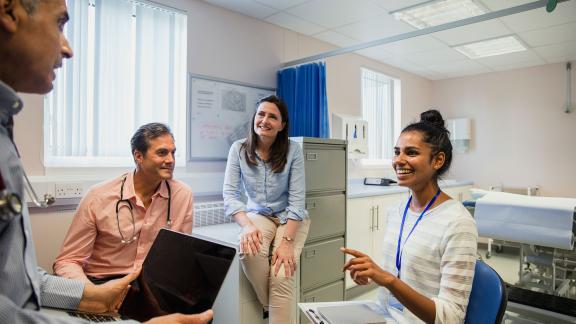Improving interface working in West Herts

West Herts Teaching Hospital NHS Trust is working across the interface with primary care on several projects to reduce admission and attendance.
Urgent and emergency care is under immense pressure. Primary and secondary care must continue in active open dialogue to improve services so we can provide the best care for our patients.
The current demand on urgent and emergency care (UEC) has continued to increase nationally with increased pressures on services, long waits for patients, and delayed care. At West Herts Teaching Hospital NHS Trust we have worked across the interface with primary care on several projects to reduce admission and attendance, providing alternative routes of care for patients with services closer to their home to help reduce the pressure and provide a better patient experience.
How we do it
This interface improvement work takes place through various multidisciplinary and multiagency forums such as a clinical advisory group, patient flow summits and targeted task and finish groups. Primary and secondary care colleagues discuss challenges and solutions using data, audit and direct experience of professionals and patients.
Our community team … takes patients directly off the ambulance stack to be seen by their own services, usually in the patient’s home
We have a number of schemes in place to support admission avoidance. Our community team, Central London Community Healthcare NHS Trust (CLCH) takes patients directly off the ambulance stack to be seen by their own services, usually in the patient’s home. Ambulance crews on scene with a patient can call alternative services such as the GP practice or CLCH rather then immediately convey to hospital, if they believe this a more appropriate route for the patient. We are also working with colleagues on pathways that may prevent a patient journey to hospital. One example is falls and head injury in patients in care homes on anticoagulants.
To ease the process of referral to hospital for further investigations, GPs use an app as a single point of access. A GP rings and speaks to a nurse controller who will give advice, suggest same-day emergency care (SDEC) or attendance for assessment or refer to the medical registrar for advice. A specialist advice and guidance service operates for less urgent questions.
The ambulance service can directly access the urgent treatment centres and SDEC with suitable patients, which reduces the demand on the emergency department (ED) and gets the patient to the right place directly for their care.
The virtual hospital is well established at West Herts, with pathways for heart failure, chronic lung disease, acute respiratory illness and frailty. This service reduces admission to hospital from the ED, reduces length of stay and prevents potential future admissions.
The keys to success
Behind all these interface improvements though are some key elements for success.
Relationships and communication
You can’t anticipate success for your interface improvements without the support of those who will need to deliver it.
People need to feel motivated and connected in wanting to make improvement across the interface work. They need to be ready for integration, be interested and want to learn how to do it. Setting up forums such as our patient flow summit meeting allows the space to have conversations around improving the interface and can aid developments and progress. This needs to be a consistent, focused and a collaborative process.
Keep repeating messages again and again. It can take time to embed changes or processes as people change roles and it is important to not give up or get frustrated with the message you are trying to convey. Repetition is important due to the complexities of the system. It’s also pivotal to have empathy and understanding of different roles and challenges, so you can work together to find solutions.
Patient pathways
Having clear and accessible pathways across the interface means they will be used more. For example, knowing a patient with deep vein thrombosis can go direct to same day emergency care and will be accepted.
Ensuring a single point of access for booking systems for tests and access for urgent tests in primary care will make the patient journey simple and straightforward.
Looking to the future
We have plans to continue our journey, with improved digital interfaces between providers to support shared decision-making. We’re also aiming for seven-day working with all elements of UEC to ensure good patient outcomes every day, and we’re expanding the virtual hospital to other conditions such as acute oncology.
As the ICS matures there will be more opportunities to extend the interface working beyond place-based to the whole system, with all the benefits of that shared experience of good practice.
With urgent and emergency care under such immense pressure, primary and secondary care must continue in active and open dialogue to improve services so we can provide the best care for our patients,
I hope our experience of improving interface working can inspire other organisations.
Dr Rachel Hoey is emergency medicine consultant and the divisional director for emergency medicine at West Herts Teaching Hospital NHS Trust. You can follow Rachel on X @RachelHoey1
Improving interface working across primary and secondary care
The NHS Confederation is running a ten-month programme of support to help primary and secondary care organisations deliver solutions-focused interface working in local areas.
Applications to join the programme are open until 22 March and the programme begins on 29 April 2024.



